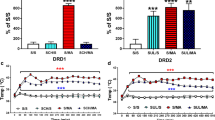Abstract
Previous work has shown that 6–12 months continuous trifluoperazine (TFP) administration to rats causes striatal dopamine receptor supersensitivity. We have now replicated our original findings in the striatum and report concurrent changes in mesolimbic dopamine function during chronic TFP (2.8–4.0 mg/kg/day) administration for 6 months. Initial inhibition of apomorphine-induced stereotyped behaviour, which lasted for 2 weeks after the beginning of drug administration, was replaced by an exaggerated response to apomorphine (0.5 mg/kg SC) after 6 months drug intake. Striatal dopamine sensitive adenylate cyclase activity was inhibited at 1 and 3 months, but by 6 months was enhanced compared to control values. Mesolimbic adenylate cyclase activity was inhibited after 2 weeks and thereafter returned to control levels. Dopamine-identified 3H-spiperone binding sites (Bmax) in the striatum were increased by 2 weeks, reduced at 1 month and increased again at 6 months. In mesolimbic areas Bmax was increased at 2 weeks and 1 month but thereafter returned to control levels. The dissociation constant (k D) of specific 3H-spiperone binding was increased in the striatum and mesolimbic areas at 1 month and 2 weeks respectively. The results show differential changes in dopamine function in striatal and mesolimbic brain areas during 6 months continuous TFP administration to rats.
Similar content being viewed by others
References
Asper, H., Baggiolini, M., Burki, H. R., Lauener, H., Ruch, W., Stille, G.: Tolerance phenomena with neuroleptic catalepsy, apomorphine stereotypies and striatal dopamine metabolism in the rat after single and repeated administration of loxapine and haloperidol. Eur. J. Pharmacol. 22, 287–294 (1973)
Carlsson, A.: Does dopamine play a role in schizophrenia? Psychol. Med. 7, 583–597 (1977)
Carlsson, A., Lindqvist, M.: Effect of chlorpromazine and haloperidol on formation of 3-methoxytyramine and normetanephrine. Acta Pharmacol. Toxicol. (Kbh.) 20, 140–144 (1965)
Clow, A., Jenner, P., Theodorou, A., Marsden, C. D.: Striatal dopamine receptors become supersensitive while rats are given trifluoperazine for six months. Nature 278, 59–61 (1979a)
Clow, A., Jenner, P., Marsden, C. D.: Changes in dopamine mediated behaviour during one years neuroleptic administration. Eur. J. Pharmacol. 57, 365–375 (1979b)
Clow, A., Theodorou, A. E., Jenner, P., Marsden, C. D.: Changes in rat striatal dopamine turnover and receptor activity during one years neuroleptic administration. Eur. J. Pharmacol. 63, 135–144 (1980)
Costall, B., Marsden, C. D., Naylor, R. J., Pycock, C. J.: Stereotyped behaviour patterns and hyperactivity induced by amphetamine and apomorphine after discrete 6-hydroxydopamine lesions of extrapyramidal and mesolimbic nuclei. Brain Res. 123, 89–111 (1977)
Crow, T. J., Deakin, J. F. W., Longden, A.: The nucleus accumbens: Possible site of antipsychotic action of neuroleptic drugs? Psychol. Med. 7, 213–221 (1977)
Davis, K. L., Hollister, L. E., Fritz, W. C.: Induction of dopaminergic mesolimbic receptor supersensitivity by haloperidol. Life Sci. 23, 1543–1548 (1978)
Gianutsos, G., Moore, K. E.: Dopaminergic supersensitivity in striatum and olfactory tubercle following chronic administration of haloperidol or clozapine. Live Sci. 20, 1585–1591 (1977)
Hitri, A., Weiner, W. J., Borison, R. L., Diamond, B. I., nausieda, P. A., Klawans, H. L.: Dopamine binding following prolonged haloperidol pretreatment. Ann. Neurol. 3, 134–140 (1978)
Jackson, D. M., Andén, N., Engel, E., Liljequist, S.: The effect of longterm penfluridol treatment on the sensitivity of dopamine receptors in nucleus accumbens and in the corpus striatum. Psychopharmacologia 45, 151–155 (1975)
Janssen, P. A. J., Niemegeers, C. J. E., Schellekens, K. H. L.: Is it possible to predict the clinical effects of neuroleptic drugs (major tranquilizers) from animal data. Neuroleptic activity spectra for rats. Arzneim. Forsch. 15, 104–112 (1965)
Kaneno, S., Watanabe, S., Toru, M., Shimazono, Y.: Different dopamine stimulation of adenylate cyclase in striatum and mesolimbic area of rats treated with chronic chlorpromazine. Brain Res. 152, 396–400 (1978)
Klawans, M. D., Jr.: The pharmacology of tardive dyskinesias. Am. J. Psychiatry 130, 82–86 (1973)
Leysen, J. E., Gommeren, W., Laduron, P. M.: Spiperone: A ligand of choice for neuroleptic receptors. Kinetics and characteristics of in vitro binding. Biochem. Pharmacol. 27, 307–316 (1978a)
Leysen, J. E., Niemegeers, C. J. E., Tollenaere, J. P., Laduron, P. M.: Serotonergic component of neuroleptic receptors. Nature 272 168–171 (1978b)
Marsden, C. D., Tarsy, D., Baldessarini, R. J.: Spontaneous and drug-induced movement disorders in psychotic patients. In: Psychiatric aspects of neurologic disease, D. F. Benson, D. Blumer, eds., pp. 219–265. New York: Grune and Stratton 1975
Miller, R. J., Horn, A. S., Iversen, L. L.: The action of neuroleptic drugs on dopamine-stimulated adenosine 3,5-monophosphate production in rat neostriatum and limbic forebrain. Mol. Pharmacol. 10, 759–766 (1974)
Muller, P., Seeman, P.: Brain neurotransmitter receptors after longterm haloperidol: Dopamine, acetylcholine, serotonin, α-adrenergic and naloxone receptors. Life Sci. 21, 1751–1758 (1977)
Sayers, A. C., Burki, H. R., Ruch, W., Asper, H.: Neuroleptic-induced hypersensitivity of striatal dopamine receptors in the rat as a model of tardive dyskinesias. Effects of clozapine, haloperidol, loxapine and chlorpromazine. Psychopharmacologia 41, 97–104 (1975)
Scatton, B.: Differential regional development of tolerance to increase in dopamine turnover upon repeated neuroleptic administration. Eur. J. Pharmacol. 46, 363–369 (1977)
van Rossum, J. M.: Significance of dopamine-receptor blockade for mechanism of action of neuroleptic drugs. Arch. Int. Pharmacodyn. Ther. 160, 492–494 (1966)
Waldmeier, P. C., Maitre, L.: Clozapine: Reduction of the initial dopamine turnover increase by repeated treatment. Eur. J. Pharmacol. 38, 197–203 (1976)
Author information
Authors and Affiliations
Rights and permissions
About this article
Cite this article
Clow, A., Theodorou, A., Jenner, P. et al. A comparison of striatal and mesolimbic dopamine function in the rat during 6-month trifluoperazine administration. Psychopharmacology 69, 227–233 (1980). https://doi.org/10.1007/BF00433087
Received:
Accepted:
Issue Date:
DOI: https://doi.org/10.1007/BF00433087




